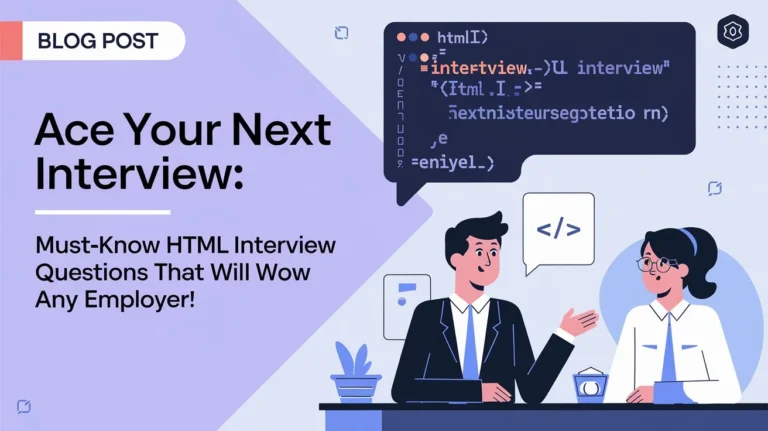Are you preparing for your next job interview and want to brush up on your HTML skills? Look no further! In this article, we’ll go through some of the most commonly asked HTML interview questions to help you land your dream job.
📝Table of Contents
1. What is HTML?
HTML (Hypertext Markup Language) is the standard language used to create webpages. It uses a series of elements (tags) to define the structure and content of a webpage. Mastering HTML is essential for any web developer, whether you’re a beginner or an experienced professional.
2. What are HTML tags and attributes?
- HTML Tags: Tags are used to create HTML elements, such as headings (
<h1>), paragraphs (<p>), or links (<a>). - Attributes: Attributes provide additional information about an element, like
hrefin<a href="https://example.com">. They always appear within the opening tag and consist of a name-value pair.
Example:
<a href="https://example.com" title="Visit Example">Click Here</a>3. What is the difference between <div> and <span>?
<div>Tag: A block-level element used to group larger content sections.<span>Tag: An inline element used to style or manipulate small parts of text.
Example:
<div>This is a block element</div>
<span>This is an inline element</span>4. Explain the different types of HTML lists.
➤HTML supports three types of lists:
- Ordered List (
<ol>): Displays items in a numbered format. - Unordered List (
<ul>): Displays items with bullets. - Definition List (
<dl>): Consists of terms (<dt>) and descriptions (<dd>).
Example:
<ul>
<li>HTML</li>
<li>CSS</li>
<li>JavaScript</li>
</ul>5. What are semantic tags in HTML?
➤Semantic tags define the purpose of the content more clearly. Examples include:
<article><section><header><footer><nav>
➤Using semantic tags improves the accessibility and SEO of your webpage.
6. How does the <meta> tag work?
The <meta> tag provides metadata about the HTML document. It’s used for SEO, defining character sets, and responsive design.
Example:
<meta name="description" content="HTML Interview Questions to Impress Employers">
<meta name="viewport" content="width=device-width, initial-scale=1">7. What is the difference between block-level and inline elements?
- Block-level elements: Start on a new line and take up the full width (e.g.,
<div>,<h1>,<p>). - Inline elements: Do not start on a new line and only take up as much width as necessary (e.g.,
<span>,<a>,<img>).
8. What are self-closing tags?
Self-closing tags don’t have a closing tag and are used for elements that don’t require content inside, such as:
<img src="image.jpg" alt="Image description" />
<br />
<hr />9. Explain the concept of HTML entities.
HTML entities are used to display reserved characters (like <, >, &) in HTML. Some common entities include:
<for<>for>&for&
10. How do you optimize a webpage for performance using HTML?
- Use minified HTML to reduce file size.
- Implement deferred loading for large scripts.
- Use semantic HTML to improve accessibility and SEO.
- Compress images and use modern formats like WebP.
11. What is the <canvas> element used for?
The <canvas> element is used to draw graphics, animations, and game elements using JavaScript. It’s commonly used for creating dynamic visual content on webpages.
12. BONUS: Tips to Impress Employers in Interviews
- Be Confident: Employers value candidates who are sure of their skills.
- Highlight Practical Experience: Show examples of projects you’ve built.
- Stay Updated: Keep up with the latest HTML5 standards.
- Know the Basics: Having a solid foundation in HTML will set you apart from others.
🎯Conclusion
By mastering these top 10+ HTML interview questions, you’ll be well-prepared to tackle any HTML-related queries in your upcoming interviews. Remember to practice regularly, stay updated on new HTML features, and showcase your knowledge confidently!
🔍Related Topic Links:
❓Frequently Asked Questions (FAQ)
Q1: What are the most common HTML interview questions?
The most common HTML interview questions include topics like HTML structure, the difference between block and inline elements, semantic HTML tags, and the use of attributes and forms. Employers often start with basic concepts and move to advanced topics depending on the role.
Q2: How do I prepare for an HTML interview?
To prepare for an HTML interview, review basic and advanced HTML concepts, practice coding exercises, and build small projects. Be ready to explain your code and demonstrate your problem-solving skills using HTML in real scenarios.
Q3: What is the difference between HTML and HTML5?
HTML5 is the latest version of HTML and includes new elements (e.g., <article>, <section>, <canvas>), attributes, and APIs like local storage and multimedia support. It also offers improved semantic structure and better support for modern web applications.
Q4: Do I need to know CSS and JavaScript for an HTML interview?
For front-end roles, a good understanding of CSS and JavaScript is often expected. However, if the position is focused on HTML, being strong in core HTML concepts and being able to integrate CSS and JavaScript will give you an advantage.
Q5: Are HTML interview questions the same for beginners and experienced developers?
No, beginners are typically asked questions on HTML basics, structure, and syntax. Experienced developers may face more complex questions about HTML5 features, optimization techniques, and building dynamic UIs.
Q6: How do I stand out in an HTML interview?
To stand out, focus on practical applications of HTML, explain your approach to problem-solving, and showcase real projects. Mentioning experience with accessibility, SEO best practices, and performance optimization can also impress employers.
